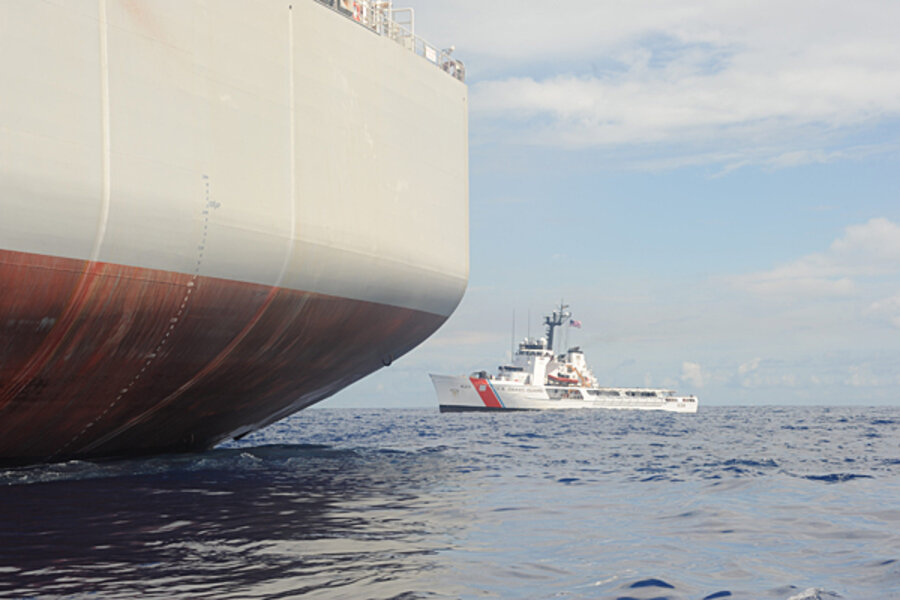Oil skimmer A Whale gets some tweaks in bid to work the BP oil spill
Loading...
| Atlanta
The verdict on the A Whale super oil skimmer is not yet in. Fifteen-foot waves in the Gulf are hampering Coast Guard tests of the 10-story-tall, 1,100-foot-long ship that started its journey to the Gulf oil spill as a "lightbulb moment" of inspiration for Taiwanese shipping magnate Nobu Su, its owner.
Though early tests of the ship's oil-collecting ability were inconclusive, spirits are reportedly running high among the 35-member crew maneuvering the A Whale near the Deepwater Horizon spill, where the oil is the thickest. Whether Mr. Su's mega ship gets hired by BP depends on the kind of oil-sucking efficiency the retrofitted iron ore tanker can demonstrate while working on a widely dispersed spill under less-than-ideal conditions.
The A Whale's capacity is said to be 300,000 barrels of oil (12.6 million gallons) collected in a 10-hour period, a 125-fold improvement over the next-largest skimmer working the spill. But that's a best-case scenario, experts say.
IN PICTURES: The Gulf oil spill's impact on nature
During the worst of the weather over the past weekend, the A Whale became the only one of nearly 550 oil skimmers to work the Gulf, highlighting its potential to help contain a spill area that could become even harder to manage if the hurricane season is volatile, as expected. With hurricane Alex last week, the Gulf saw its first June hurricane in 15 years.
"Even given the conditions, this ship has been an incredible warrior," says Frank Maisano, a spokesman for Su's company, TMT Shipping Offshore, in a phone interview. "Our sense is that there's a need that is not being fulfilled in the deeper water with skimming, and we can address that need."
Retrofitting of the A Whale cost TMT millions, and it's not clear what the company would seek in compensation if the Coast Guard deems it a viable oil-slick attacker.
But Su insists that the A Whale isn't simply a business opportunity. "This is an opportunity to do something that no one else can do and about having the wherewithal to put your idea into action," Mr. Maisano says.
The potential to make an impact on America's biggest oil spill appears to be exciting for the crew of A Whale, which is accustomed to shipping iron ore around the globe. Described by Maisano as "a fun and interesting" bunch, the crew members, all from India, have displayed Bollywood jollity in front of TV cameras and impressed visitors with the quality of the food on board the ship.
At work, the crew is making technical tweaks in a bid to improve the ship's oil collection in rough seas. Though the A Whale's huge dimensions allow it to ride out rough waters, its size could also be a detriment as the super-skimmer vies for a spot on the response team. Oil from the spill is widely dispersed, and so those in charge of the response are ramping up the numbers – not necessarily the size – of vessels, aiming to put 750 skimming vessels to work by mid-July.
To date, skimmers have collected more than 671,000 barrels (28.2 million gallons) of oil and water mix from the Gulf. Between 2 million and 4 million barrels of crude are believed to have leaked into the Gulf already.
Whether or not it succeeds in the Gulf, the A Whale shows that a host of new ideas are emerging to try to contain major deepwater spills, says Dennis Bryant, a former Coast Guard officer and now a maritime consultant in Gainesville, Fla.
"The increased focus on research and development in oil-spill response is long overdue," says Mr. Bryant. "The other thing that's going to happen is that the amount of response resouces that are kept stockpiled in the United States will increase. Right after the Exxon Valdez accident [in Alaska in 1989], the response capability of this country ramped up rapidly and then slowly dropped over time because we weren't having big spills. Now we have a big spill and we've discovered that we don't have the necessary boom and skimmers."
IN PICTURES: The Gulf oil spill's impact on nature
Related:





